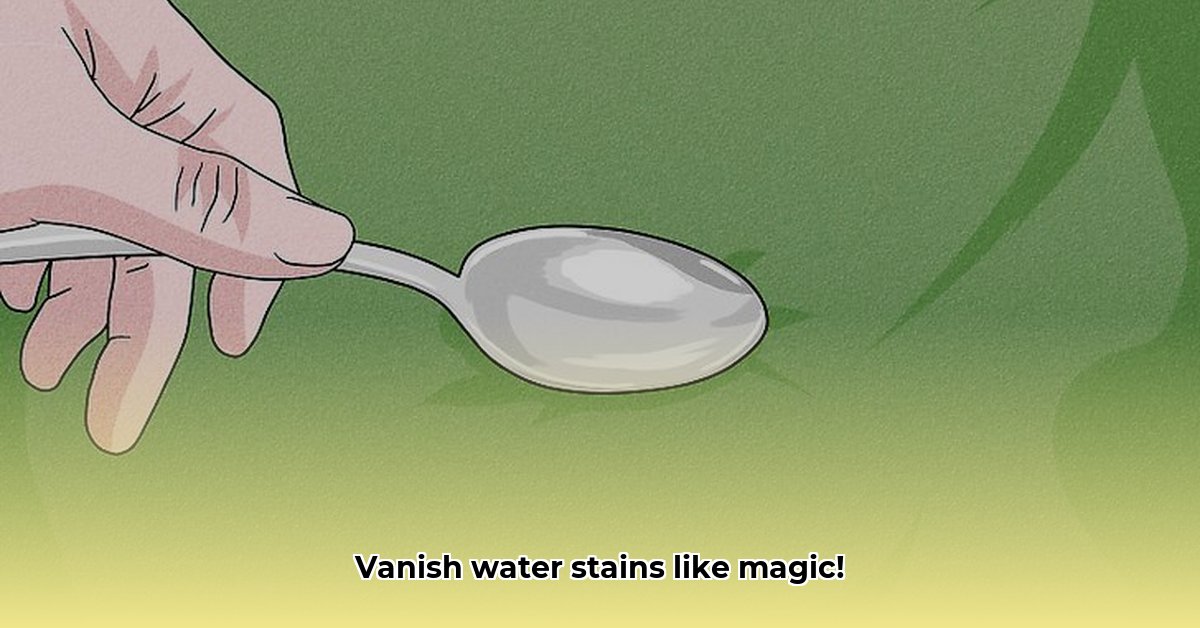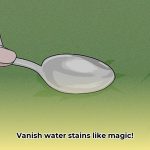Water stains can be a frustrating nuisance, whether they appear on your favorite blouse or your plush sofa. This comprehensive guide offers practical, step-by-step instructions, combining Martha Stewart’s attention to detail with wikiHow’s directness, to help you banish those unsightly marks and restore your items to their pristine beauty.
Understanding and Tackling Water Stains
Before we dive into solutions, let’s understand the enemy. Water stains aren’t simply the residue of dried liquid. They often consist of minerals left behind as water evaporates. Hard water, rich in calcium and magnesium, is a common culprit. These minerals, harmless in your water, become noticeable when left on surfaces. Other factors, such as lurking dirt, dyes in the fabric, or cleaning product residues, can also contribute to water stains. The age and temperature of the water also play a role – fresh spills are easier to address, and warmer water evaporates faster, potentially leaving a more concentrated mineral deposit.
Banishing Watermarks: A Step-by-Step Guide
1. The Gentle Art of Blotting
Action: Gently blot the stain with a clean, white cloth. Avoid rubbing, as this can spread the stain and damage the material. Think of it like dabbing a delicate watercolor painting.
Why this works: Blotting absorbs excess moisture without pushing the stain deeper into the fibers.
2. Distilled Water: A Purifying Rinse
Action: Dampen a clean cloth with distilled water and blot the affected area. Distilled water, free of minerals often found in tap water, can dissolve and lift mineral deposits.
Why this works: Distilled water helps dissolve the minerals without adding more to the problem.
3. The Vinegar Solution: A Natural Wonder
Action: Mix a solution of one part white vinegar to three parts distilled water in a spray bottle. Lightly mist the stain, then blot with a clean cloth. Repeat if necessary.
Why this works: The mild acidity of vinegar breaks down stubborn mineral deposits, especially effective on upholstery. Always test in an inconspicuous area first, especially on delicate fabrics.
4. Steam Cleaning: A Gentle Persuasion for Delicates
Action: For delicate fabrics like silk and wool, hold the garment a few inches away from a steamer. Allow the gentle steam to loosen the stain, avoiding harsh scrubbing.
Why this works: Steam loosens minerals and lifts the stain without harsh scrubbing or chemicals.
5. Baking Soda Paste: A Deep Cleaning Treatment
Action: For persistent stains, mix baking soda with a little distilled water to create a paste. Apply to the stain, let sit for 15-20 minutes, then gently brush away with a soft cloth.
Why this works: Baking soda acts as a gentle abrasive, lifting deep-set stains without harsh chemicals.
Fabric-Specific Stain Removal Strategies
| Fabric | Recommended Method(s) | Important Considerations |
|---|---|---|
| Cotton | Mild detergent, baking soda paste, ironing | Cotton is durable but avoid aggressive scrubbing. Ironing can be effective. |
| Polyester | Distilled water, diluted white vinegar, ironing (low heat) | Test vinegar in a hidden area. Polyester can be sensitive, especially to high heat. |
| Silk | Steam cleaning, distilled water | Silk is extremely delicate; handle with care and avoid rubbing. Professional cleaning is sometimes recommended. |
| Wool | Steam cleaning, distilled water, diluted white vinegar | Blot gently; harsh rubbing can damage wool fibers. |
| Upholstery | Diluted white vinegar, steam cleaning, baking soda paste | Always test cleaning solutions in an inconspicuous spot. Consider the upholstery material’s specific care instructions. |
| Linen | Ironing, laundering, diluted white vinegar | Similar to cotton, linen responds well to ironing. |
| Velvet | Gentle blotting with distilled water, professional cleaning | Velvet is sensitive; professional cleaning is recommended for best results. |
| Suede | Professional cleaning (highly recommended) | Water can easily damage suede. Avoid DIY methods unless experienced. |
Preventing Water Stains: Proactive Measures
Prevention is often simpler than removal. Implement these strategies:
- Fabric Protectors: Create a barrier that repels water on furniture and clothing.
- Filtered Water: Use distilled or filtered water for cleaning and in appliances like irons and humidifiers. If you have hard water, consider a water softener.
- Even Drying: Ensure even drying to prevent water spots. Use a fan or open a window for air circulation.
- Immediate Action: Blot spills immediately to minimize staining.
Troubleshooting Stubborn Stains & Professional Help
For stubborn stains, repeat your chosen method, or try a commercial stain remover designed for the specific fabric. Always test in a hidden area first. For delicate or expensive items, or persistent stains, professional cleaning is the safest and most effective option. Search for “water stain removal services near me” to find local experts.
Ongoing Research and Evolving Solutions
While these methods are effective, ongoing research is constantly exploring new cleaning methods, including enzymatic cleaners. The effectiveness of any method can depend on factors like water hardness, fabric dyes, and humidity. This is an active area of study, so be sure to explore new information as it becomes available.
- How to Remove Water Stains from Fabric: A Complete Guide - April 26, 2025
- How to Get Motor Oil Out of Clothes: Proven Methods & Expert Tips - April 26, 2025
- How to Get Deodorant Out of Black Shirts: Easy Stain Removal Guide - April 26, 2025










